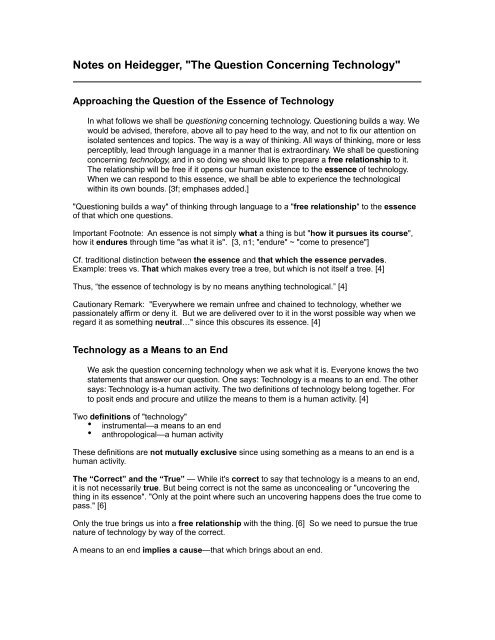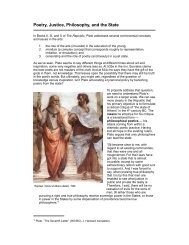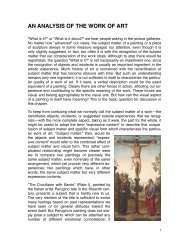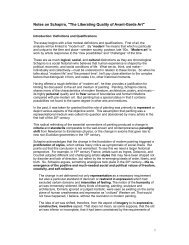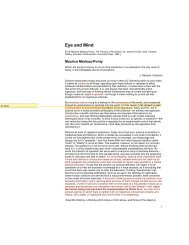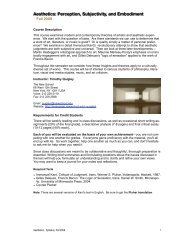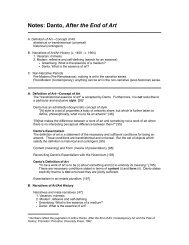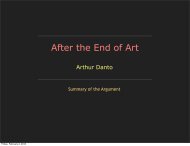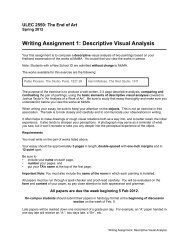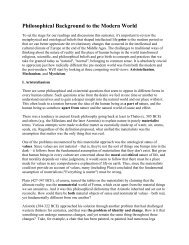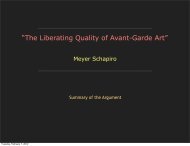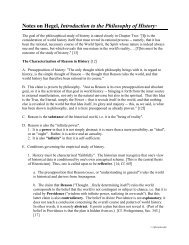Notes on Heidegger, "The Question Concerning Technology"
Notes on Heidegger, "The Question Concerning Technology"
Notes on Heidegger, "The Question Concerning Technology"
- No tags were found...
Create successful ePaper yourself
Turn your PDF publications into a flip-book with our unique Google optimized e-Paper software.
Interpreting Aristotle's Four Causes—Four Ways of Being Resp<strong>on</strong>sibleC<strong>on</strong>trary to the comm<strong>on</strong> interpretati<strong>on</strong> of Aristotle’s four causes in instrumental terms,<strong>Heidegger</strong> claims the material, formal, final, and efficient causes are the ways in which a thingis held resp<strong>on</strong>sible or indebted. To understand what <strong>Heidegger</strong> has in mind here, we need tofocus <strong>on</strong> suggestive examples of making and the c<strong>on</strong>cepts he develops to give us a pretechnologicalunderstanding of the process.We’ll start with the example of a marble sculpture of a discus thrower. In <strong>Heidegger</strong>’s terms, thestatue is “indebted” to the material (marble), the form (discus thrower), and the goal(memorializing a heroic athlete). <strong>The</strong> sculptor, as efficient cause, gathers together the "aspectsof indebtedness"—matter, form, and goal—and "brings forth" (poiēsis) the sculpture. Thus, thebringing or "bursting forth" happens through the artist. This distinguishes it from the bringingforth in nature (physis) of an object. In the latter case, it has the bringing forth in itself. But it’simportant to note that the activity of the artist does not take place apart from the othercomp<strong>on</strong>ents or causes gathered by the artist’s activity, i.e. how the work is brought forth. [9-12]Now what is this bringing forth? How does it happen in nature and in art? <strong>Heidegger</strong> says, “<strong>The</strong>four ways of being resp<strong>on</strong>sible bring something into appearance. <strong>The</strong>y let it come forth intopresencing [An-wesen]. <strong>The</strong>y set it free to that place and so start it <strong>on</strong> its way, namely, into itscomplete arrival.” [9] <strong>The</strong> bringing-forth “is a unified process, ‘a single leading-forth to which [eachof the causes] is indebted’”. 1Aristotle’s Four Causes• Material — matter (hyle) is resp<strong>on</strong>sible [7]• Formal — form (morphe) is resp<strong>on</strong>sible [7]• Final — goal (telos) is resp<strong>on</strong>sible [8]• Efficient — maker is resp<strong>on</strong>sible for gathering together the other three [8]According to <strong>Heidegger</strong>, all four are interwoven and “co-resp<strong>on</strong>sible” for what is made.Albert Borgmann’s example of the wheelwright is helpful in getting the phenomena in fr<strong>on</strong>t of us. 2• Material — wood [bottom of 44]• Formal — wag<strong>on</strong>; the form brought forth from the wood [45]• Final — purpose linked to the particular wood and shape of the wag<strong>on</strong> [45]• Efficient — wheelwright works respectfully with nature (“human to nature”) [44]Borgmann c<strong>on</strong>trasts the wheelwright’s wag<strong>on</strong> with a technological device — a watch — to showthat instrumental means and ends in technological producti<strong>on</strong>, in which the product — the what— is the <strong>on</strong>ly real c<strong>on</strong>cern, are not overriding or determining in the traditi<strong>on</strong>al mode of revealingand producti<strong>on</strong>.<strong>The</strong> bringing-forth is also part of an unc<strong>on</strong>cealing. "Bringing-forth comes to pass <strong>on</strong>ly insofar assomething c<strong>on</strong>cealed comes into unc<strong>on</strong>cealment [alētheia]." [11]But what does this have to do with the essence of technology? "Everything…[for] technology is away of revealing." [12]1William Lovitt, “A Gesprach with <strong>Heidegger</strong> <strong>on</strong> Technology”, from David I. Waddingt<strong>on</strong>, “A Field Guide to<strong>Heidegger</strong>: Understanding ‘<strong>The</strong> Questi<strong>on</strong> C<strong>on</strong>cerning Technology’”, Educati<strong>on</strong>al Philosophy and <strong>The</strong>ory, Vol.37, No. 4, (2005), 569.2Albert Borgmann, Technology and the Character of C<strong>on</strong>temporary Life, Chicago: University of ChicagoPress, 1987. This applicati<strong>on</strong> to <strong>Heidegger</strong>’s interpretati<strong>on</strong> of the four causes was developed in Sean Kelly’sseminar course <strong>on</strong> <strong>Heidegger</strong>’s late works, Harvard Univ., 22 Oct 2008.2
Freedom governs the open in the sense of the cleared and lighted up, i.e., of the revealed. Itis to the happening of revealing, i.e., of truth, that freedom stands in the closest and mostintimate kinship. All revealing bel<strong>on</strong>gs within a harboring and a c<strong>on</strong>cealing. But that whichfrees—the mystery—is c<strong>on</strong>cealed and always c<strong>on</strong>cealing itself. All revealing comes out of theopen, goes into the open, and brings into the open. <strong>The</strong> freedom of the open c<strong>on</strong>sists neitherin unfettered arbitrariness nor in the c<strong>on</strong>straint of mere laws. Freedom is that which c<strong>on</strong>cealsin a way that opens to light, in whose clearing there shimmers that veil that covers whatcomes to presence of all truth and lets the veil appear as what veils. Freedom is the realm ofthe destining that at any given time starts a revealing up<strong>on</strong> its way. [25]"[O]nce we open ourselves expressly to the essence of technology, we find ourselvesunexpectedly taken into a freeing claim." [26]<strong>The</strong> DangerBut at the same time, since <strong>on</strong>e is pushed in the directi<strong>on</strong> of the ordering of modern technology(Enframing), <strong>on</strong>e runs the risk of seeing <strong>on</strong>ly the power of this calculable and instrumentalordering of nature.<strong>The</strong> essence of technology lies in Enframing. Its holding sway bel<strong>on</strong>gs within destining. Sincedestining at any given time starts man <strong>on</strong> a way of revealing, man, thus under way, isc<strong>on</strong>tinually approaching the brink of the possibility of pursuing and pushing forward nothingbut what is revealed in ordering, and of deriving all his standards <strong>on</strong> this basis. Through thisthe other possibility is blocked, that man might be admitted more and so<strong>on</strong>er and ever moreprimally to the essence of that which, is unc<strong>on</strong>cealed and to its unc<strong>on</strong>cealment, in order thathe might experience as his essence his needed bel<strong>on</strong>ging to revealing.Placed between these possibilities, man is endangered from out of destining. <strong>The</strong> destining ofrevealing is as such, in every<strong>on</strong>e of its modes, and therefore necessarily, danger. [26]<strong>The</strong>re is always the danger that human beings will misinterpret the being of their age by placingso much emphasis <strong>on</strong>, for example, cause and effect relati<strong>on</strong>s that their interpretati<strong>on</strong> of beingoverwhelms that aspect of truth as the c<strong>on</strong>cealed or hidden, thereby losing touch with the “open”aspect and the inherent mystery of truth. <strong>Heidegger</strong> seems to be referring to the influence ofmodern science <strong>on</strong> philosophical thinking going back at least to the 17 th century.In whatever way the destining of revealing may hold sway, the unc<strong>on</strong>cealment in whicheverything that is shows itself at any given time harbors the danger that man may quail at theunc<strong>on</strong>cealed and may misinterpret it. Thus where everything that presences exhibits itself inthe light of a cause-effect coherence, even God can, for representati<strong>on</strong>al thinking, lose all thatis exalted and holy, the mysteriousness of his distance.In a similar way the unc<strong>on</strong>cealment in accordance with which nature presents itself as acalculable complex of the effects of forces can indeed permit correct determinati<strong>on</strong>s; butprecisely through these successes the danger can remain that in the midst of all that iscorrect the true will withdraw.<strong>The</strong> destining of revealing is in itself not just any danger, but danger as such…. Yet whendestining reigns in the mode of Enframing, it is the supreme danger. [26]What is “the supreme danger”? It shows up in two ways.As so<strong>on</strong> as what is unc<strong>on</strong>cealed no l<strong>on</strong>ger c<strong>on</strong>cerns man even as object, but does so, rather,exclusively as standing-reserve, and man in the midst of objectlessness is nothing but theorderer of the standing-reserve, then he comes to the very brink of a precipitous fall; that is,5
he comes to the point where he himself will have to be taken as standing-reserve. Meanwhileman, precisely as the <strong>on</strong>e so threatened, exalts himself to the posture of lord of the earth. Inthis way the impressi<strong>on</strong> comes to prevail that everything man encounters exists <strong>on</strong>ly insofaras it is his c<strong>on</strong>struct. [27]1. Thus, it seems to a pers<strong>on</strong> in the technological age that they “everywhere and always” <strong>on</strong>lyencounter themselves, when in truth they never encounter <strong>on</strong>ly themselves. [27]Man stands so decisively in attendance <strong>on</strong> the challenging-forth of Enframing that he doesnot apprehend Enframing as a claim, that he fails to see himself as the <strong>on</strong>e spoken to, andhence also fails in every way to hear in what respect he ek-sists, 3 from out of his essence, inthe realm of an exhortati<strong>on</strong> or address, and thus can never encounter <strong>on</strong>ly himself. [27;emphases added.]Thus, the danger in this limitati<strong>on</strong>, viz., that the truth will remain hidden and that man will seehimself as c<strong>on</strong>trolling nature; and in so doing, enframe human being itself as standing-reserve.2. But, perhaps even more important is that <strong>on</strong>e runs the risk of misinterpreting the being of thepresent age as necessary, rather than c<strong>on</strong>tingent.Enframing does not simply endanger man in his relati<strong>on</strong>ship to himself and to everything thatis. As a destining, it banishes man into that kind of revealing which is an ordering. Where thisordering holds sway, it drives out every other possibility of revealing. Above all, Enframingc<strong>on</strong>ceals that revealing which, in the sense of poiesis, lets what presences come forth intoappearance. As compared with that other revealing, the setting-up<strong>on</strong> that challenges forththrusts man into a relati<strong>on</strong> to that which is, that is at <strong>on</strong>ce antithetical and rigorously ordered.Where Enframing holds sway, regulating and securing of the standing-reserve mark allrevealing. <strong>The</strong>y no l<strong>on</strong>ger even let their own fundamental characteristic appear, namely, thisrevealing as such.Thus the challenging Enframing not <strong>on</strong>ly c<strong>on</strong>ceals a former way of revealing, bringing-forth,but it c<strong>on</strong>ceals revealing itself and with it That wherein unc<strong>on</strong>cealment, i.e., truth, comes topass. [27]Thus, the final danger is that the essence of technology may c<strong>on</strong>ceal that a mode of revealing isoccurring and is c<strong>on</strong>tingent—<strong>on</strong>ly <strong>on</strong>e mode of revealing am<strong>on</strong>g other possibilities. [27f]Art and the “Saving Power”"But where danger is, grows<strong>The</strong> saving power also." Hölderlin [28]By questi<strong>on</strong>ing technology we raise the possibility of freeing ourselves from the danger. Once werealize the truth of the Enframing, we may put it in its place as we also bring to light other aspectsof the essence of technology.3“Ek-sistence” (a term coined by <strong>Heidegger</strong>) is Dasein’s “standing out into the truth of Being”, a term thatmarks the sense in which we are beings who are c<strong>on</strong>nected to Being. Elsewhere he writes: “Man is rather‘thrown’ from Being itself into the truth of Being, so that ek-sisting in this fashi<strong>on</strong> he might guard the truth ofBeing, in order that beings might appear in the light of Being as the beings they are. Man does not decidewhether and how beings appear, whether and how God and the gods or history and nature come forwardinto the clearing of Being, come to presence and depart. <strong>The</strong> advent of beings lies in the destiny of Being.But for man it is ever a questi<strong>on</strong> of finding what is fitting in his essence that corresp<strong>on</strong>ds to such destiny; forin accord with this destiny man as ek-sisting has to guard the truth of Being. Man is the shepherd ofBeing.” [Martin <strong>Heidegger</strong>, “Letter <strong>on</strong> Humanism”.]6
Every destining of revealing comes to pass from out of a granting and as such a granting. Forit is granting that first c<strong>on</strong>veys to man that share in revealing which the coming-to-pass ofrevealing needs. As the <strong>on</strong>e so needed and used, man is given to bel<strong>on</strong>g to the coming-topassof truth. <strong>The</strong> granting that sends in <strong>on</strong>e way or another into revealing is as such thesaving power. For the saving power lets man see and enter into the highest dignity of hisessence. This dignity lies in keeping watch over the unc<strong>on</strong>cealment—and with it, from thefirst, the c<strong>on</strong>cealment—of all coming to presence <strong>on</strong> this earth. It is precisely in Enframing,which threatens to sweep man away into ordering as the supposed single way of revealing,and so thrusts man into the danger of the surrender of his free essence—it is precisely in thisextreme danger that the innermost indestructible bel<strong>on</strong>gingness of man within granting maycome to light, provided that we, for our part, begin to pay heed to the coming to presence oftechnology.Thus the coming to presence of technology harbors in itself what we least suspect, thepossible arising of the saving power.Everything, then, depends up<strong>on</strong> this: that we p<strong>on</strong>der this arising and that, recollecting, wewatch over it. [32]<strong>Heidegger</strong> suggests that the poetic aspect of art as technē—the revealing of the true as comingto presence in the beautiful, not as standing-reserve—could give rise to poetic revealing. [34f]<strong>The</strong> model, for <strong>Heidegger</strong>, is the art of the ancient Greeks, which provided works that revealedbeings as the beings they are and focused a society around a certain understanding of being.<strong>The</strong> arts were not derived from the artistic. Art works were not enjoyed aesthetically. Art wasnot a sector of cultural activity.What, then, was art—perhaps <strong>on</strong>ly for that brief but magnificent time? Why did art bear themodest name technē? Because it was a revealing that brought forth and hither, and thereforebel<strong>on</strong>ged within poiēsis. It was finally that revealing which holds complete sway in all the finearts, in poetry, and in everything poetical that obtained poiēsis as its proper name. [34]“Could it be”, <strong>Heidegger</strong> asks, “that the fine arts [today] are called to poetic revealing?”Whether art may be granted this highest possibility of its essence in the midst of the extremedanger, no <strong>on</strong>e can tell. Yet we can be astounded. Before what? Before this other possibility:that the frenziedness of technology may entrench itself everywhere to such an extent thatsomeday, throughout everything technological, the essence of technology may come topresence in the coming-to-pass of truth.Because the essence of technology is nothing technological, essential reflecti<strong>on</strong> up<strong>on</strong>technology and decisive c<strong>on</strong>fr<strong>on</strong>tati<strong>on</strong> with it must happen in a realm that is, <strong>on</strong> the <strong>on</strong>e hand,akin to the essence of technology and, <strong>on</strong> the other, fundamentally different from it.Such a realm is art. But certainly <strong>on</strong>ly if reflecti<strong>on</strong> <strong>on</strong> art, for its part, does not shut its eyes tothe c<strong>on</strong>stellati<strong>on</strong> of truth after which we are questi<strong>on</strong>ing. [35]Timothy Quigley19 Nov 09 (revised 21 Nov 11)7
Discobolus, Roman copy of a br<strong>on</strong>ze original, 5th century BC. From Hadrian's Villa in Tivoli,Lazio, Italy (British Museum)8


